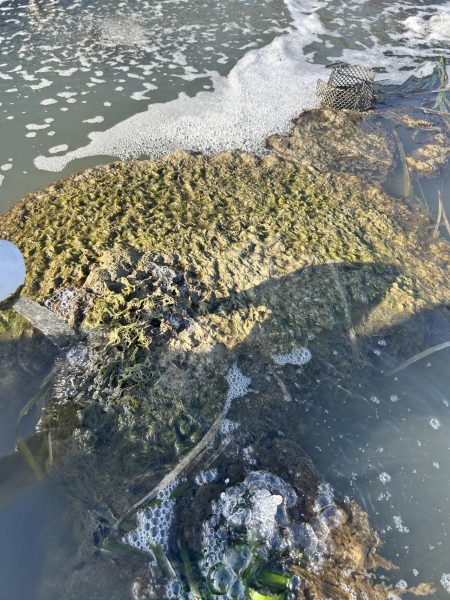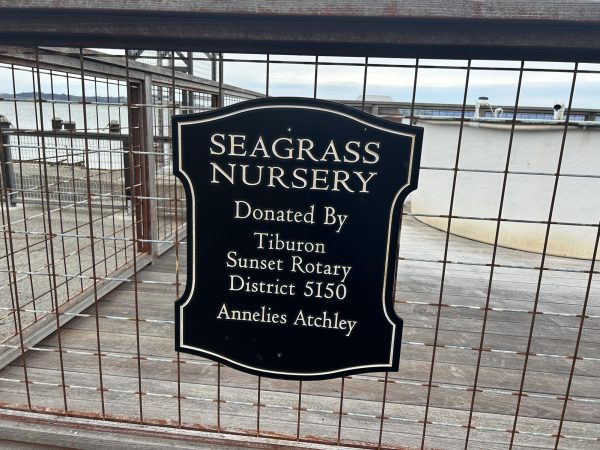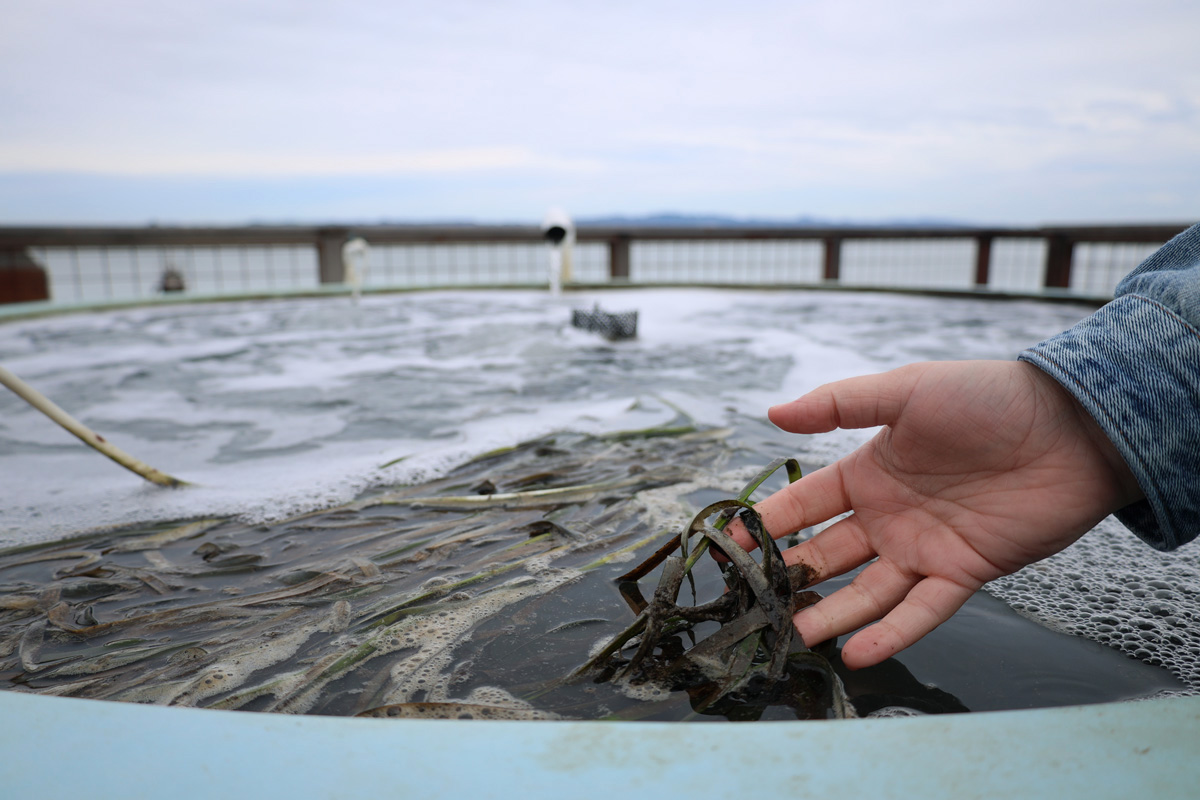The air bubbles from the eelgrass touch tank are very distinct. There is something growing under the surface of the Bay Area water. It is eelgrass in all of its slimy but roughly textured glory. If you look closely, there are tiny living organisms on the grass itself.
Next to the tank is a sign, much like one would find at a museum or zoo, it explains the eelgrass meadow and the importance of these green underwater plants. Eelgrass, or zostera marina, is a flowering plant that lives underwater on coastlines, in estuaries and sounds on every continent except Antarctica. Eelgrasses protect coastlines from erosion and sealevel rise as well as provide interspecies habitats globally.
The plant, named for its slimy but rough, eel-like blades, grows in patchy meadows. Eelgrass is a type of seagrass, similar to the familiar terrestrial grasses, that have flowers that emerge each summer, undergo pollination and drop seeds by fall. Seagrasses are some of the few true plants of the ocean.
In the San Francisco Bay and Estuary, eelgrass covers about 3,000 acres of submerged land, according to the informational board next to the interactive tank. Scientists estimate there are as many as 30,000 acres where it could live now.
San Francisco State University’s satellite campus, the Romberg Tiburon campus, has this interactive tank for students and visitors to learn about the ecosystem captured in eelgrass. The slimy strands of eelgrass are available for anyone to walk by and touch. The Romberg Tiburon campus is home to SF State’s Estuary and Ocean Science Center (EOS), the only marine research center located on the bay.
Katharyn Boyer is the interim executive director of the Estuary and Ocean Science Center at SF State’s Romberg Tiburon campus. She specializes in wetland and coastal ecology. Her research lab focuses on restoration, community ecology, biodiversity, ecosystem function, nutrient dynamics, trophic interactions and habitat structure.
“We want people to be engaged with sea level rise and understand how it’s affecting their communities and how it’s affecting the bay,” Boyer said.
The Boyer Lab’s research focuses on foundational habitats such as tidal marshes, seagrass beds and oyster reefs.

Eelgrass Restoration
During the Gold Rush, hydraulic mining washed hillside sediment down the rivers and into the estuary, limiting the ability for seagrasses to thrive in the cloudy water. According to the EOS Center, water clarity is improving and there are fewer fine sediments in the water. It may lead to better conditions for eelgrass meadows and help eelgrass restoration efforts.
The Boyer Lab at the EOS Center researches environmental conditions and its impacts on estuarine species. The lab team is working on eelgrass and oyster reef restoration, among other efforts toward coastal resilience. Due to the effects of climate change, particularly ocean warming, the bay can become murky from algae overgrowth, limiting the sunlight that reaches eelgrass.
Kai Burrus is a professor of biology at SF State. They are also co-director of Climate HQ, a campus empowerment organization that develops initiatives to advance climate justice.
“They are doing the planting of the eelgrass and monitoring of those sites, the repopulating the oysters, and many people looking at many different aspects of the bay health,” Burrus said. “Without people stewarding the bay, the health of the bay is going to be really in peril, and I worry for all of the various impacts on the Bay Area.”
Cayla Sullivan is the watershed management specialist at the US Environmental Protection Agency (EPA) in the Long Island Sound office. Sullivan and her team are a part of the 28 National Estuary programs throughout the country.
“We have a couple projects underway right now that are really going to help inform us [in] future restoration efforts,” Sullivan said.
When she joined the program five years ago, there were gaps in the mapping of eelgrass, but after community efforts with the Long Island Sound EPA office, the team was able to accomplish what they set out to do.
“We need to know where it is in order to protect it,” Sullivan said. “Mapping efforts, more monitoring efforts, whether they be water quality or actual, monitoring the seagrass meadows itself, we also identified the need for updating our eelgrass habitat suitability index model, and that model really pinpoint areas that are suitable for restoration activities.”
Sullivan and her team have begun an innovative, long-term eelgrass restoration initiative. They will be using the seeds of the plant instead of the actual full-grown plant to rehabilitate lost meadows. Historically, when practitioners would restore the meadows they would take a young shoot –– an entire plant –– and manually dig it into the ocean ground.
“There’s been new evidence and research showing that actually using the seeds is more cost effective, less labor intensive and get, essentially, more bang for your buck,” Sullivan said.

The Importance of Eelgrass
Eelgrass meadows are powerful carbon sinks, according to Environment America. Carbon sinks are ecosystems that sequester and absorb more carbon than they release, often through the process of photosynthesis. Carbon sinks are an essential part of the carbon cycle that reduces greenhouse gases.
Dr. Sarah Cohen is a professor of biology at SF State. She has worked with Boyer on eelgrass and seagrass research. She researches marine evolution and genetic systems, including genetic diversity among local eelgrasses.
“These underwater habitats protect us in so many ways,” Cohen said, in regards to seagrass beds. “They can also serve as carbon sinks, in a time where we really need carbon sinks.”
This plant captures carbon dioxide and methane from the atmosphere and stores it in the root system and sediment beneath them, making them valuable allies to terrestrial forests, potentially mitigating climate change.
These grass beds also provide habitat for fish species. According to Cohen, there are fish that rely on that habitat to reproduce. “What do we risk if we don’t have these things?” Cohen asked. “We risk all of our marine resources. 70% of the globe is covered with water.”
At the University of Washington, Dr. Jennifer Ruesink is a professor of biology. Her research focuses on estuarine organism interactions and oyster and eelgrass habitats.
“Washington state has a very complicated coastline, [and] has a simple habitat for zostera marina in coastal estuaries, which are very large, second only to San Francisco Bay,” Ruesink said.
Ruesink said her team conducts field research in the intertidal zone, the space between high and low tides. The work is primarily done at low tide, exposing eelgrass located in the soft-sediments that make for murky water.
“It is a plant and it has to support all the biological activity of its underground stem and roots –– which is not photosynthetic,” Ruesink said. “That is an energy cost to the plant, [meaning] that relative to the phytoplankton and micro algae that grow on it, it needs more light, but it’s very good at getting nutrients so it has traditionally been dominant in places low in nutrients.”
The access to sunlight, or lack thereof, shifts conditions in favor of algae over seagrasses. Ruesink called seagrass a “canary in a coal mine” for water quality and shoreline activities which impact the quality of estuary water.
“Eelgrass is the most widely distributed marine plant, and it’s pretty widely distributed compared to terrestrial plants,” Ruesink said.
Mitigating Climate Change Impacts
This leads to the question: Can eelgrass mitigate the effects of climate change? According to Ruesink, eelgrass is more sensitive to low light and competition than algae.
“Whether seagrass is going to save us from climate change, I just feel like I’m not going to put my faith in that,” Ruesink said. “I don’t think it is a powerful enough species to overcome the massive changes that humans are making to the planet.”
Ruesink added that it ultimately depends on where the eelgrass is located.
Catie Thow Garcia is the first resiliency and sustainability manager for the city of Sausalito. Garcia got her master’s degree in interdisciplinary marine and estuarine sciences from SF State’s Estuary and Ocean Science Center in 2022.
“You need healthy eelgrass populations to have healthy herring populations,” Garcia said. “Without healthy herring populations, you don’t have humpback whales, and you don’t have the tourism that comes to the Bay Area to see the humpback whales. So, it really goes beyond so far, just like one little organism, one little aquatic grass that’s in the bay.”
A wasting disease caused by a fungus called lambria zosteria infects the seagrass leaves. Sullivan said the wasting disease will leave black scarring on the eelgrass, and the flowering plant will eventually die if not treated. In the 1930s, there was a large epidemic on the East Coast so severe the eelgrass will never make a full recovery.
If more eelgrass were to die off there would be what Sullivan calls a “cascading impact.” The impact would begin from a lower level of the ecosystem, for example, not having a habitat for marine species such as fish and shellfish, which then impact fisheries and recreational and commercial fishing.
“It is something that researchers are still very much concerned about,” Sullivan said. “They have been trying to understand how it is induced and how to actively mitigate it. That’s something that we struggle with today.”
Eelgrass beds have large impacts throughout the world and on the chain of the environmental process. The meadows have long existed, and the preservation and restoration are significant not only for the Bay Area but for other estuaries around the world.





